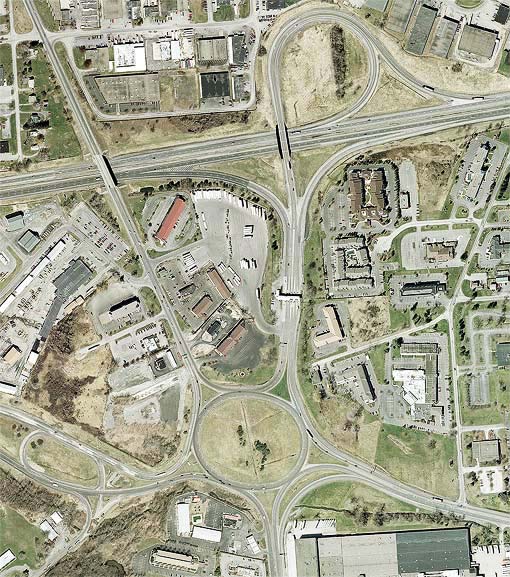I-90 & NY 298
 |
| A
full-size image (316 KB)
is also available. |
Introduction: Traffic circles are considerably less common in New York State than in other areas, particularly New England. Furthermore, they are far less numerous in New York today than during the first half of the twentieth century. This is because they do not adequately serve modern traffic volumes and design standards for safety and capacity. Most of the remaining traffic circles are on low-volume streets, usually in residential areas or parks. However, a few major ones remain, while a great many more have been upgraded to interchanges and other intersection types. One design that has recently come into favor among traffic engineers, including at NYSDOT, is the modern roundabout. This week and next, Interchange of the Week will examine the different degrees to which these outmoded highway features have been modernized. (Last week's feature, the Bruckner Interchange in New York City, is itself an extreme example of this kind of upgrade.)
 |
| A
full-size image (316 KB)
is also available. |
Orientation: Carrier Circle, named for the nearby HVAC-manufacturing company, is at bottom center. Its approaches, counterclockwise from the upper left, are: Thompson Road, NY 298 (joined by Court Street Road just west of the circle), NY 635 (Thompson Road), NY 298 (Carrier Parkway), and the New York State Thruway ramp. The New York State Thruway (I-90) is of course the freeway from left to right at top.
Exit numbers: Carrier Circle is Exit 35 from the Thruway, signed for NY 298 to East Syracuse (it is actually NY 635 that leads to East Syracuse; NY 298 leads to northern Syracuse). This is a typical "trumpet" interchange, used on almost all Thruway exits to local roads, allowing for a single toll plaza to serve all approaches. Also, each branch of Carrier Circle is numbered as an exit: Exit 1 is Thompson Road northbound, then continuing counterclockwise: Exit 2 is NY 298 westbound, Exit 3 is NY 635 (Thompson Road) southbound, Exit 4 is NY 298 (Carrier Parkway) eastbound, and the New York State Thruway (I-90) is Exit 5.
The circle: This is one of few major traffic circles remaining in more or less its original form. Some modifications have been made, however. Notice that some of the connections have exclusive right turn lanes, so that traffic travelling between two adjacent approaches need not merge with traffic in the circle. In the case of NY 635 to NY 298 eastbound, this lane is a completely separate roadway. In the cases of NY 298 westbound to the Thruway and Thompson Road southbound to NY 298 westbound, this lane is delineated by pavement markings only.
Also note the design of NY 298 west of Carrier Circle: it is divided, with a wide median to accomodate left turn and U-turn channels providing access to and from intersecting roads, such as Court Street Road, seen here. This type of design is found throughout NY 298 between Carrier Circle and General Motors Circle (a twin to Carrier Circle, just west of the photo area), and farther west to Teall Avenue. Court Street Road is an older iteration of modern NY 298. The dead-end street just to the right of the Thruway ramp where it meets the circle, is also part of Court Street Road, and would have intersected the circle before the Thruway was constructed.
Carrier Circle boasts perhaps the greatest concentration of lodging
places
in the State; more than a dozen are visible in this photo.
 |
Orientation: NY 198, the Scajaquada Expressway, runs from bottom right to top left. Parkside Avenue runs from the circle to top right, running along the perimeter of Delaware Park. Medaille College is at bottom left, and has an access road to the circle. Humboldt Parkway forms a service road on either side of NY 198, coming in from the bottom right and ending at the circle.
The intersection: In this case, the circle remains, but no longer forms any functional purpose in the junction. It has been superseded by a fairly standard crossroad intersection, favoring traffic to and from Parkside Drive. There are channelized right turn lanes to and from the latter street, as well as a prominent dedicated left turn lane on NY 198 eastbound. This intersection is the only at-grade junction on NY 198, which is otherwise a fully controlled-access freeway. Southeast of the circle, short slip ramps are visible to and from Humboldt Parkway: these serve NY 5 (Main Street) and Kensington Avenue, which pass over NY 198 just off the bottom right.
The circle: The former traffic circle, most likely named for the Swiss naturalist Louis Agassiz (1807-73), today merely forms segments of surrounding streets. From the ground it is difficult to visualize the circle formation. The circle's east quadrant is now simply the end of Humboldt Parkway northbound, while the south quadrant is the beginning of Humboldt Parkway southbound. The north quadrant, essentially obliterated, is occupied by an entry road for Delaware Park. This road is only available to traffic on southbound Parkside Drive: no left turn is allowed northbound. Further, cross traffic from Humboldt Parkway to the park road is prohibited. Northbound traffic must enter the park a short distance to the north, at Jewett Avenue. In fact, the entry road at Agassiz Circle may soon or already be entirely closed to vehicular traffic. Finally, the circle's west quadrant forms part of Meadowview Place and provides access to a small, isolated residential area, here visible in its entirety, adjoining Medaille College.
The City of Buffalo boasts a considerable number of small circles,
mostly
of ceremonial design, and highly landscaped residential boulavards, in
addition
to extensive park development, in its northern neighborhoods. This is
due
in large part to the city's prominence early in the twentieth century,
among
other things as host of the 1901 Pan-American Exposition.